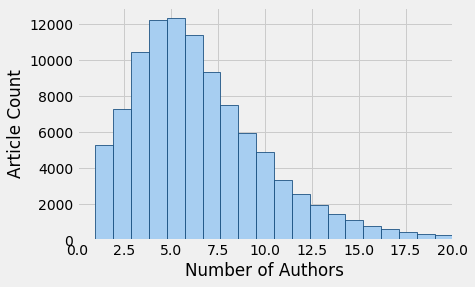I analyzed a random sample of 101,580 full-text research papers, uploaded to PubMed Central between the years 2016 and 2021, in order to explore the influence of the number of authors of a research paper on its quality.
I used the BioC API to download the data (see the References section below).
Here’s a summary of the key findings
1. The median research paper had 6 authors, with 90% of papers having between 1 and 15 authors.
2. The median number of authors of a research paper increased, from 3 to 6, in the past 20 years. The data also show that single-authored papers are becoming less popular, as the percentage of single-authored papers dropped from 33.9% in 2002 to 2.1% in 2021.
3. Descriptive studies (such as case reports, case series, and cross-sectional studies) usually require less work and therefore have fewer authors than analytical studies (such as cohort, case-control, and experimental studies).
4. The number of authors does not influence the quality of the journal in which the research paper is published. In fact, the median single-authored paper is published in a journal with an impact factor of 3.11 compared to 3.15 for the median multiple-authored paper.
5. Single-authored research papers receive 34.7% less yearly citations compared to multiple-authored papers (p < 0.01).
1. How many authors can a research paper have?
The following is a histogram representing the distribution of the number of authors:

The graph shows that:
- The distribution of authors has a right skew, as expected.
- Most research papers have less than 10 authors.
- It is somewhat exceptional for a research paper to have more than 15 authors.
Here’s a table that summarizes these data in numbers:
| Sample Size | 101,580 research papers |
|---|---|
| Mean | 7.2 authors |
| Minimum | 1 author |
| 25th Percentile | 4 authors |
| 50th Percentile (Median) | 6 authors |
| 75th Percentile | 9 authors |
| Maximum | 2,902 authors |
In our sample of 101,580 research papers, the median research paper was written by 6 authors, and the majority had between 4 and 9 authors. Only 5% were written by single authors (n=5,280).
A physics paper had 2,902 authors, which was the largest number of contributors to a single work in our sample (here’s the link to the paper on PubMed).
2. Number of authors: 20-year trend
The 20-year trend shows that the median number of authors increased from 3 in 2002 to 6 in 2012 and remained constant for the past decade:
Looking at the trend of single-authored papers below, we see that these are declining in popularity over the past 20 years:
Perhaps that collaborations are more encouraged nowadays, especially for larger projects.
If this is the case, then the number of authors should differ for various study designs, as different types of studies require different amount of work. So, this is what we are going to discuss next.
3. Number of authors of different article types
The following table shows the median number of authors of different article types:
| Study Design | Median Number of Authors |
|---|---|
| Case Report | 5 |
| Case Series | 5 |
| Quasi-Experiment | 5 |
| Pilot Study | 6 |
| Cross-Sectional | 6 |
| Meta-Analysis | 6 |
| Systematic Review | 6 |
| Case-Control | 7 |
| Randomized Controlled Trial | 7 |
| Cohort Study | 8 |
The data agree with the hypothesis that descriptive studies (such as case reports, case series, and cross-sectional studies) usually require less amount of work and therefore have fewer authors — medians between 5 and 6 authors — than analytical studies (such as cohort, case-control, and experimental studies) — medians between 7 and 8 authors.
4. Number of authors of papers in different journals
To study the influence of the number of authors on the quality of the journal in which the paper is published, I used linear regression to predict the journal impact factor given the number of authors.
Here’s the outcome of that model:
| Variable | Coefficient | Standard error | p-value |
|---|---|---|---|
| (Intercept) | 3.57 | 0.01 | < 0.01 |
| Number of authors | 0.03 | < 0.01 | < 0.01 |
The model shows that research papers with more authors are published in slightly higher-quality journals: an increase in 1 author is associated with an increase of 0.03 in the journal impact factor. Although statistically significant, this effect is practically negligible.
In addition, when comparing the median journal impact factor for single-authored and multiple-authored research papers, I found only a difference of 0.04 (3.11 and 3.15, respectively)
5. Does the number of authors influence the citation count?
In order to study the influence of the number of authors of a paper on the number of citations it receives, I used Poisson regression to model the number of citations per year given the number of authors.
The model shows that research papers that have 1 additional author are associated with a 0.62% increase in the yearly citation count. For the median article, this means an increase of 1 citation every 100 years — with is negligible.
However, when we compare single-authored with multiple-authored papers, the Poisson model shows that the yearly citation count for single-authored papers is 34.7% less compared to multiple-authored papers (p < 0.01). Specifically, the median number of yearly citations for single-authored papers was 1.4 compared to 2.2 for multiple-authored papers.
References
- Comeau DC, Wei CH, Islamaj Doğan R, and Lu Z. PMC text mining subset in BioC: about 3 million full text articles and growing, Bioinformatics, btz070, 2019.